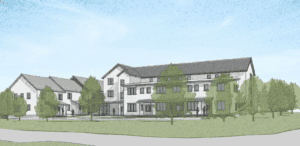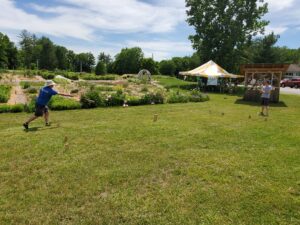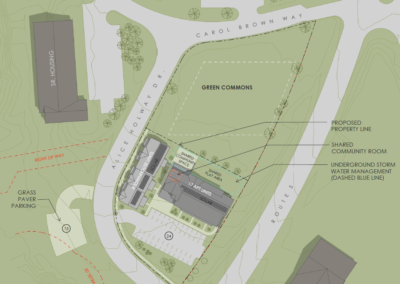
How can a community address the challenge of creating affordable housing while at the same time conserving its green spaces? WWHT’s new housing project in Putney is designed to do just that, and promises to be greater than the sum of its parts. Working collaboratively with Green Commons of Vermont, the Housing Trust developed an exciting concept for a mixed-use site that incorporates 25 new, quality, and affordable homes abutting a cherished green space in Putney. From concept comes design which the Housing Trust has been working on with feedback from Green Commons.
The nearly 4-acre site historically was part of Governor George Aiken’s wildflower nursery and since 2010, the northern portion of the parcel has been home to the Putney Farmers’ Market and the Putney Community Garden. At the close of this, their 12th season, the market saw close to 40 weekly vendors, and the gardens produced bountiful crops of vegetables, raspberries and flowers on nearly 60 plots.
From its outset, the Putney project has been grounded in community participation and dialogue. As WWHT engaged the community in a series of meetings and discussions, a new non-profit group emerged, made up of stakeholders from the Putney Farmers’ Market, the Community Garden, and community members. Green Commons of Vermont was formed with a mission to acquire, preserve, protect, and maintain green spaces for community engagement and education in Putney. The two groups worked closely and collaboratively on creating a conceptual plan that would preserve the gardens, leave space to expand the Farmers’ Market, and house 25 new homes all on the same parcel.

WWHT Executive Director Elizabeth Bridgewater explains the vision. “As we started to consider possible site designs, we were committed to a vision that preserved these important community resources, to offer opportunities to develop collaborative programming. I most look forward to identifying resources around nutrition, food cultivation, and land stewarding. Food insecurity has been highlighted as a true concern during the pandemic. It’s exciting to think about households who previously paid over half their income to housing could now use that freed income to invest in healthy food available just steps away.”
“What I am most excited about with this collaboration is the chance to increase the number of ways people can enjoy this wonderful sunny space,” says Louise Garfield, Community Garden and Green Commons board member.
WWHT has contracted with Vermont Integrated Architecture to design the site with guidance from Green Commons, and has maintained a strong focus on meeting community needs. Still in the design phase, the housing will be made up of one- and two-bedroom homes, built to Vermont’s high standards of energy efficiency, and linked to public transportation and pedestrian access. Community spaces will include a multi-purpose room with potential for an industrial kitchen. In addition to preserving the existing garden and market activities, Green Commons is developing plans to add to their space. Ideas that have come up include active and rest areas for all ages—small “parklets”— with benches and natural material play structures. The group is raising funds to own the northern portion of the parcel outright.
Working with WHHT on our shared vision of creating community space has been a highly involved, collaborative effort.” Says Alexis Doshas, Putney Farmers’ Market vendor and Green Commons board member. “WWHT has been very supportive of Green Commons of VT’s mission of preserving green spaces for community use.”
Louise Garfield agrees. “The inclusion of directors in all steps of the design process–facilitating interchange with architects, engineers, and financial consultants— has been an exciting learning process for all of us.”
Elizabeth Bridgewater explains why Putney is an important community to invest in.
“As is the case with all of Vermont, Putney is experiencing a severe housing crisis, and has been for some time. Putney is also a wonderful place to live with strong community, plenty of engagement opportunities, and is home to families who have been in Putney for generations as well as folks who have recently discovered it. There’s a vibrant arts scene, progressive climate action, and strong value for agriculture, conservation, and preservation. This new project addresses the desperate need for affordable housing while embracing every one of these values.”
The Town has already done a significant amount of groundwork to move the project forward. The project fits well within the Town Plan priorities for compact land use development. It also effectively demonstrates the roles compact development and affordable housing play in a just transition strategy to meet the State’s climate goals.
“Creating new housing on this plot means that folks who couldn’t traditionally afford to build a house with high energy performance and green technology have access to living in it,” says Elizabeth Bridgewater. “It means these folks don’t have to drive long commutes in inefficient vehicles to their jobs, childcare, or grocery stores. Climate action should not only be accessible to high income populations. Housing adjacent to gardens and Farmers’ Market with a shared community space facilitates a natural connection between all three. We are so excited to be working with Green Commons on this exciting project.”
Special thank you to the Farmers Market and Community Garden for contributing pictures.





